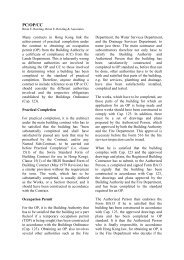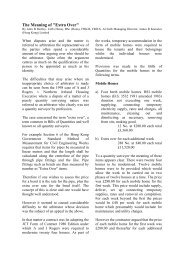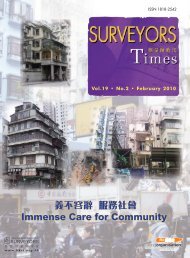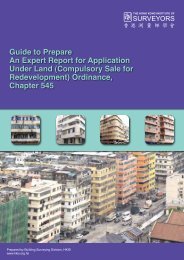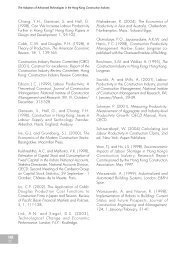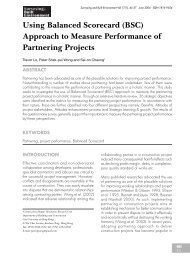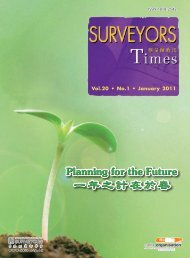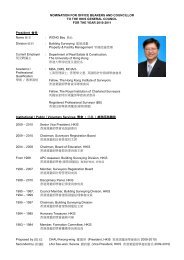Surveying & Built Environment Vol. 22 Issue 1 (December 2012)
Surveying & Built Environment Vol. 22 Issue 1 (December 2012)
Surveying & Built Environment Vol. 22 Issue 1 (December 2012)
Create successful ePaper yourself
Turn your PDF publications into a flip-book with our unique Google optimized e-Paper software.
INTRoduCTIoN<br />
The Demarcation District (DD) Survey<br />
was a comprehensive boundary survey<br />
which covered the New Territories<br />
between 1899 and 1905. A DD Sheet,<br />
under the deeds registration system, is a<br />
registered plan with a boundary clause<br />
stating that the lot boundaries were<br />
“particularly delineated”.<br />
There is no spatial coordinate<br />
framework on a DD Sheet. The geodetic<br />
control information of the DD Survey<br />
has been unavailable in recent decades.<br />
Thus, the exact positioning accuracy of<br />
DD Sheets cannot be checked directly.<br />
In a plane-table survey done in the<br />
period of 1900’s, the survey plan could<br />
possibly claim a good accuracy up to 1<br />
mm. It means that the surveyed features<br />
are drawn accurately on the plan which<br />
is within 1 mm on the plan to the ‘true’<br />
position. Accumulated professional<br />
experience and research results on using<br />
DD sheets indicate that field bunds in<br />
a good accuracy DD sheet should have<br />
achieved the 1 mm accuracy within<br />
a standard deviation (Zhang & Tang,<br />
<strong>2012</strong>).<br />
Much that has been published on<br />
the DD Sheet, (Leung et al, 2008)<br />
confirms its nature as the product of a<br />
land occupation survey. This theme is<br />
followed in this paper. The reliability of<br />
the inherent graphical accuracy of DD<br />
Sheet is analysed. And, it is suggested<br />
that the agricultural occupation pattern<br />
should be used to reasonably represent<br />
the DD images.<br />
<strong>Surveying</strong> and <strong>Built</strong> <strong>Environment</strong> <strong>Vol</strong> <strong>22</strong>, 74-87 Nov <strong>2012</strong> ISSN 1816-9554<br />
dIRECT<br />
GEo-REfERENCING<br />
dd SHEET WITH<br />
fIEld SuRVEYING<br />
CooRdINATES<br />
Direct geo-referencing means that<br />
the coordinates’ control information<br />
is applied directly onto the selected<br />
features of the un-coordinated plan<br />
image. The basic principle is to find<br />
out the coordinates of some significant<br />
landmarks on the DD Sheet providing<br />
that a feature that existed in 1905 can<br />
still be seen as the same intact land<br />
boundary feature today. The georeferencing<br />
function of a Geographic<br />
Information System (ArcGIS 9.2 is<br />
used in this project) applies the current<br />
coordinates of the selected features<br />
to the corresponding features on<br />
DD Sheet. In theory, given the scale<br />
and the north direction, one control<br />
point (define x and y coordinate) is<br />
sufficient to determine 4 parameters<br />
in a horizontal datum. However,<br />
after the DD Sheet scanning, the<br />
scale and direction information need<br />
to be defined again. So, at least two<br />
control points are needed to perform<br />
DD Sheet geo-referencing. Different<br />
numbers of control points and different<br />
transformation algorithms will give<br />
different results. This paper gives<br />
examples using a subject area in the<br />
Kam Tin Demarcation District Sheet<br />
(DD 109) as shown in figure 1.<br />
SBE<br />
75




